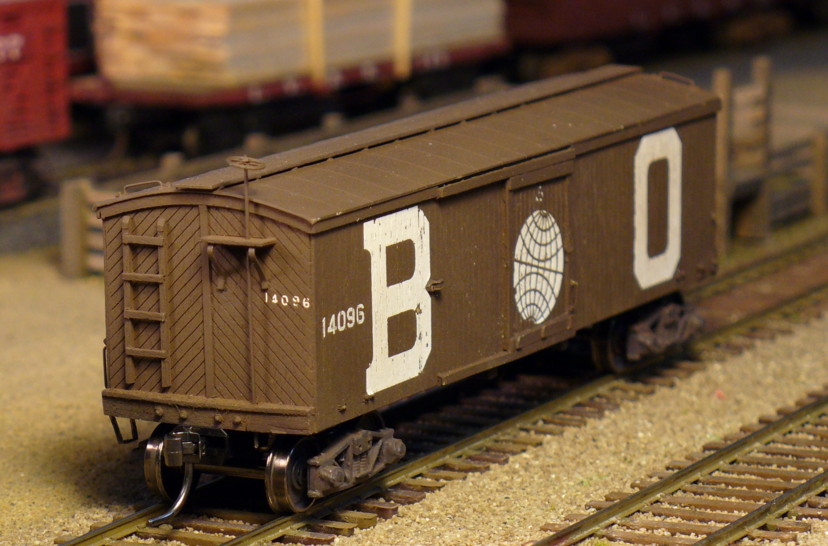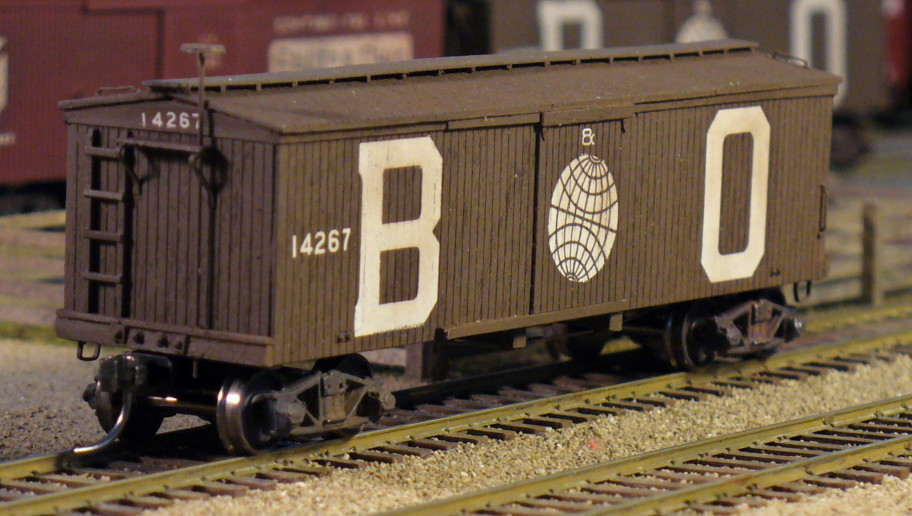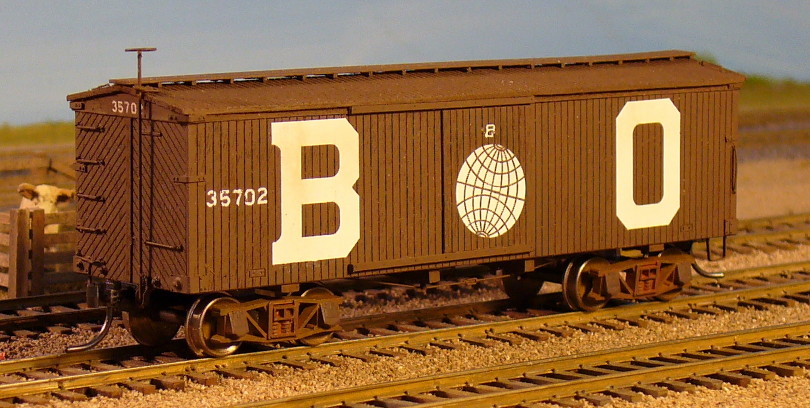Building Early B&O Boxcars from B.T.S. Kits
In 2007 B.T.S. released laser cut wood kits of the B&O M-2 boxcar, as well as a modified version of the kit sold as a generic boxcar. From these kits I modeled the B&O M-2, M-3 and M-5 boxcars. This is a modified version of an article I wrote for the May/June 2008 issue of The B & O Modeler
The M-2 Boxcar
According to the 1888 Official Railroad Equipment Register there were only 95 cars of the M-2 type in the 14001-14099 number series. The kit manufacturer gives a build date of circa 1870.The B.T.S. kit goes together easily if the builder follows the detailed and clear directions. The result is a model with square corners and plumb sides. Nevertheless, I did make some modifications, largely to make the car look closer to prototype photos of early B&O boxcars, and to provide a few more details.
The exposed end beams in the kit appear a little too thick to me, so I made my own from 8 by 8 and 2 by 10 stripwood. Similarly, the fascia looked too wide. The instructions say to glue the fascia to the sides and ends before attaching the subroof and roof. This leaves the edges of the wood subroof showing. Instead, I attached the subroof first, sanded the edges flush with the sides, and then attached the roof, making sure it was centered side-to-side and end-to-end. Finally, I installed the fascia; it now covers the edges of the subroof and snuggles up to the underside of the roof.
I modified the door by leaving off the diagonal bracing; the car diagram does not have this bracing, and it would only get in the way of lettering. I used door stops from the Tichy Boxcar Door Hardware part 3070 and added nut-bolt-washer castings (Grandt Line 5045) to grabirons on the roof and sides, as I do with all my models.
Trucks are from Bethlehem Car Works (part no. 134).

The M-3 Boxcar
First built in 1883 when railroads were still running many 28 to 30ft boxcars, the M-3 was longer but about the same height as the earlier cars. Unlike B&O boxcars that preceded it and several types that followed, it apparently had vertical sheathing rather than the distinctive herringbone ends. The ORER for 1888 lists 868 cars in the 14100-14999 number series, and 179 in the 33000-33579 series.I modified a B.T.S. 33 9 1870 Radial Roof boxcar kit so that I would have the vertical board ends. To obtain the peaked roof, I simply modified the core ends and end sheathing. I found this was easier to do before the pieces were removed from the sheets of wood they come in. I also did the same for several of the carlines, those roof supports that run from side-to-side in the car.
I cut out scribed sheetwood for the roof, and used the roofwalk and its supports from the kit. Fascia was constructed from 1 by 4 stripwood for the sides, and 1 by 12 for the ends.
The generic boxcar kit comes with grabirons for the ends, but the M-3 car diagram shows a ladder, so I used the ladders from an M-2 kit I was planning to use to kitbash the M-5.
As with the M-2 described above, I fashioned my own end beams. Car diagrams do not show the number of trussrods for the M-3, but in general four were used on cars of this length, so four I built. The square nut-bolt-washer castings are GrandtLine part 5096. I left off the door bracing.
The modeler must decide where to add grabirons on the sides and ends because the car diagrams are no help and I did not have photos. I pretty much followed the same placement as the M-2.

The M-5 Boxcar
The M-5 was built in 1886 and in greater number than any of its 34ft predecessors. According to the 1888 ORER, there were approximately 2,000 cars in number series 34002-34501 and series 35500-36999. This car reverts back to the herringbone end, so I started with the B.T.S. kit for the M-2. I located a photograph of an M-5 in the Summer& Fall 2000 issue of the Blue Mountain Express, quarterly newsletter of the Western Maryland Historical Society. It shows the side and a good part of the end. From the photo I could see that the car diagram was fairly accurate.I built my model about the same way as the M-3, with one important difference. The M-5 was about 4 inches taller than the earlier car, so after building the core and adding the sheathing-trimmed for the peaked roof of course-I added lengths of 4 by 4 stripwood to the tops of the sides and ends before fitting the carlines and roof. The 1 by 4 fascia on the sides and 1 by 12 fascia cut to fit for the ends hide the vertical extensions.
Following the photo, I built new body bolsters from 4 by 12 stripwood, simply glued to the underframe with the ends exposed under the side sheathing. I moved the body bolsters closer to the center of the car to accommodate trucks of longer wheelbase, such as the Kadees. I typically glue a block of scale 6 by 12 by 18 wood to the body bolster where the trucks mount; the thickness depends on the trucks to be used.
The photo shows grabirons on the ends rather than ladders, so I simply used the ones that came with the generic boxcar kit. Once again I elected to mount four trussrods using the nylon line and turnbuckles supplied in the kit. I used 3 queenposts on this car (Grandt Line. 5052). Note that this car lacks the exposed end beams of previous cars. Grant Line 5093 form nut-bolt-washers for the two inner truss rods. I also added corner braces to the ends (Grandt Line 5159).
I used the kit brakewheel, but found some Grand Line castings in my parts box for the ratchet mechanism at the roof and the brakestaff support at the bottom of the end.
I found the old pair of Cape Line trucks in my parts box.
Paint and Lettering
I painted all cars with Floquil Roof Brown following a suggestion I read in an e-mail. I dont know for certain that this color is correct for the period I model, but at least it makes for distinctive cars and looks appropriate. Ive seen similar colors used on buildings of that era and it must have been cheap.Lettering is from Clover House. I debated what to use on the earliest cars, but photographs from the period show yards full of boxcars with this globe design, with some variations. The photo of the M-5 on the Western Maryland shows this lettering scheme.